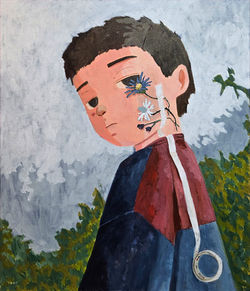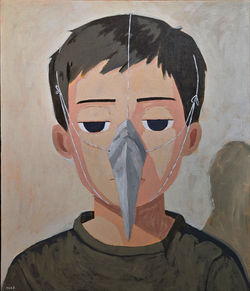Tang Contemporary Art Bangkok is proud to present Everything Was Where It Wasn’t, a solo exhibition by Filipino artist TRNZ, curated by Michela Sena. In this new body of work, TRNZ deepens his investigation into the fragile architecture of everyday life, revealing a world in quiet disarray where logic loosens, time folds in on itself, and the familiar slips gently into the unfamiliar.
In Everything Was Where It Wasn’t, TRNZ unveils a series of new paintings that radiate a subtle, dreamlike sense of displacement. This is not a violent dislocation, but a delicate, suspended condition, one that mirrors the peculiar sensation of dreaming, where meaning drifts, memory fractures, and emotional coherence dissolves. Each canvas seems to hover just outside the frame of narrative time, inviting viewers into a dimension that is both deeply intimate and quietly disoriented, a space where objects repeat with slight variations, moments occur out of sequence, and nothing ever fully resolves.
At first glance, TRNZ’s visual language, drawn from Japanese animation and graphic storytelling, appears accessible, even playful. Often identified with the new wave of Filipino artists, TRNZ has developed a style rooted in clean lines and visual clarity. But beneath this approachable surface lies a far more elusive and poetic exploration. TRNZ uses the familiar vocabulary of popular visual culture not to simplify, but to complicate. Through this recognizable and stylized lens, he evokes highly nuanced states of being: solitude, displacement, introspection, and emotional ambiguity.
His characters often appear suspended in states of quiet hesitation, caught in the spaces between action and reflection. They do not speak; they do not act. They simply are, isolated yet universal, contained within their own atmospheres. In this way, TRNZ masterfully expresses a main condition of contemporary life: the shared isolation that paradoxically connects us all. We are alone and in that aloneness, profoundly together.
Through subtle distortion and deliberate misplacement, TRNZ destabilizes not only physical environments but also psychological landscapes. Repetition, here, is not used to create rhythm, but to suggest dysfunction, a looping of gestures and forms that once made sense, but no longer do. This is the fatigue of the procedural world, rendered in soft hues and silent composition. Domestic scenes are revisited with slight shifts, introducing an uncanny discomfort. These are not scenes of spectacle, but of suggestion. The rupture is not loud, but internal.
The emotional tone of the work is not explosive, but restrained; and it is in this very restraint that TRNZ achieves his most profound effects. His paintings do not ask for attention, but they hold it. They do not confess, but behave with a quiet persistence that draws the viewer inward. The stillness in his work is never passive; it is charged with suspension, with waiting, with a sense that something unspoken lies just beneath the surface.
TRNZ does not offer conclusions. Instead, he creates space, intimate, reflective, and deeply human. Through a poetic misordering of time, space, and emotion, he blurs the boundary between the structural and the sentimental. In the gaps between the two, something flickers: vulnerable, displaced, but unmistakably present.
With Everything Was Where It Wasn’t, TRNZ offers a vision of contemporary life that is both gentle and unflinching. It is a portrait of our emotional terrain, quiet, subtle, disjointed, rendered with remarkable clarity and sensitivity. He does not impose meaning, but allows it to emerge softly, like a memory. In doing so, TRNZ shows us a mirror of ourselves: not as fixed identities, but as fleeting presences, each navigating our own suspended interiors, always close, always apart.
This exhibition invites viewers into that shared inner landscape, a space without linear time, where forms repeat and meanings slide, where everything is just slightly out of place. A space where, paradoxically, everything is exactly where it wasn’t and yet where we recognize ourselves most clearly.
Text: Michela Sena
EXHIBITING WORKS
 Key Performance Indicators Acrylic on canvas 80 x 100 cm 2025 |  A Technical Foul for Nothing in Particular Acrylic on canvas 100 x 80 cm 2025 |  Woke up in the Wrong-Sized Headspace Acrylic on canvas 80 x 100 cm 2025 |
|---|---|---|
 The Inventory of Extinct Plastics Acrylic on canvas 80 x 100 cm 2025 |  Cutting as a Kind of Pattern Acrylic on canvas 120 x 100 cm 2025 |  Left-Handed Sentiments Acrylic on canvas 120 x 100 cm 2025 |
 Clearance Sale on All Soft Things Acrylic on canvas 120 x 100 cm 2025 |  Low-Maintenance Vertical Garden Acrylic on canvas 120 x 100 cm 2025 |  Velvet Snakes in the Cinema Backroom Acrylic on canvas 120 x 150 cm 2025 |
 Arranged Alphabetically, Not by Affection Acrylic on canvas 150 x 200 cm 2025 |  The Indoor Parade of Mislabeled Houseplants Acrylic on canvas 200 x 150 cm 2025 |  Rubber Band Standoff Acrylic on canvas 60 x 70 cm 2025 |
 Fragrance Layering Acrylic on canvas 70 x 60 cm 2025 |  The Boy who Auditioned as the Bird Acrylic on canvas 70 x 60 cm 2025 |
Artist

TRNZ
b. 1992, based in the Philippines
Terence Eduarte, better known as TRNZ, is a Filipino visual artist, who holds a BFA in Advertising from the University of Santo Tomas, and began his career as an art director at TBWA/SMP. He was introduced to art through locally dubbed Japanese animation that aired daily on 90s television. From 2017, he began focusing more on visual artwork with a perspective shaped by his advertising experience, expanding his work to a multimedia approach, and turned to focus more on Fine Arts.
TRNZ is an artist with a penchant for mis-arrangement – the past, concepts, emotions, and the intangible. He recontextualizes tangible elements, placing them in unconventional settings where their absurdity defies conventional logic, yet somehow feels as though they belong. His work explores the instability hidden within the everyday. Through misarrangement, repetition, and subtle shifts, he reconstructs the familiar into scenes where logic falters and meaning bends.
Working with restrained color and stillness, TRNZ creates images that hold tension quietly, drawing viewers into spaces where memory, control, and contradiction blur. In his hands, dislocation is not rupture, but a quiet, inevitable realignment of how things are seen and held.



